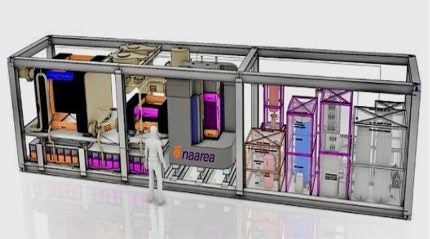
France-based nuclear start-up Naarea (Nuclear Abundant Affordable Resourceful Energy for All) and Assystem are to establish a joint laboratory to support further development of a digital twin for Naarea’s XAMR microreactor. The lab will evaluate, analyse and integrate all of the emerging technologies that could contribute to the deployment, optimisation and ongoing improvement of the XAMR digital twin.
Naarea, founded in 2020 by Jean-Luc Alexandre and Ivan Gavriloff, is developing the XAMR (eXtrasmall Advanced Modular Reactor) (40MWe or 80MWt). The XAMR is a molten salt fast neutron micro-generator capable of producing electricity and heat from long-lived used fuel waste produced by current conventional reactors.
The laboratory will aim to meet future challenges related to the development of the XAMR, bringing together the technical and professional expertise of Naarea and Assystem, in collaboration with universities, research centres and public institutions.
Naarea says that it has reached a key step in the development of the microreactori just 18 months, by finalising the first stage of the digital twin in partnership with Assystem. The digital twin was developed on Dassault Systèmes’ 3DX platform, and centralises all the data pertaining to the reactor. It will be used throughout the project’s lifecycle, from its design through to operation and reprocessing.
As digital technologies are constantly evolving, the lab will integrate all of the relevant emerging technologies such as large language models (LLMs), substitution models, the dynamic reliability of passive safety systems, and the Internet of Things (IoT).
To do so, Naarea and Assystems developed a five-year strategic roadmap in three areas:
- The integration stages for the main nodes of system tree structures;
- The main groups of processes to be integrated into the digital twin;
- The main technological building blocks likely to be integrated into the digital twin.
The engineering teams of Naarea and Assystem, as well as the public and private research units that wish to join the laboratory, will contribute their expertise, resources and specific skills to the
project. The laboratory will be based on the principle of sharing resources, whether material or immaterial, thus allowing each partner to collectively access knowledge and resources that might not necessarily have been accessible to them individually.
The joint laboratory will be led by a strategic steering committee comprising senior management of Naarea and Assystem, who will approve the roadmap and funding. A management committee will provide operational oversight for its R&D activities and may be assisted by Naarea’s Scientific Board to guide the scientific and technological aspects of the laboratory.
“We are delighted to continue and expand our partnership with Naarea to contribute to the enrichment of their digital twin,” said Christian Jeanneau, Executive Vice President International, Project Management & Digital at Assystem. “Thanks to our expertise and the use of artificial intelligence, this joint laboratory represents a tremendous opportunity to innovate together. It will allow us to develop new solutions to continuously improve this large-scale project and address the energy challenges of the future.”
According to Naarea’s website the company has established an ambitious timetable marked by three main phases:
- Mid-2023: finalisation of the first digital twin
- 2027: commissioning of a prototype
- 2030: construction of a manufacturing facility and launch of series production
In December 2021, Naarea signed a cooperation agreement with Assystem to build the XSMR and to develop a digital twin of the reactor. The twin will enable rapid convergence towards the optimal design, provide critical elements for validating the design and enable the rapid launch of the construction of the physical prototype, Naarea said.
The joint laboratory aims to bring together skills and expertise to explore the most promising digital technologies that could contribute to improving the digital twin,” said Naarea founder & CEO Jean-Luc Alexandre. “Beyond the exceptional knowledge we’ll gain from it, and state of the art digital technologies, this laboratory embodies the spirit of innovation that drives all of the teams involved in the design and development of our XAMR.”






